A Practice for the Transition from Summer to Fall
The seasons have a profound effect on us, and I find it so interesting how these effects show up. In our modern world, we often don’t make the connection between how we feel and the natural world around us.
I have a private student who came for her session recently, feeling really scattered, pulled in different directions and wanted to find some settling. She also said she was burned out from the tremendous activity of the Summer. She felt too fiery, and wanted to cool down somehow.
This perfectly echoes what we often go through in the transition from Summer to Fall.
In Ayurveda (the Science of Life, a sister science of yoga), the Summer is associated with the Pitta biological energy (or dosha), which is all about the element of FIRE. Activity, excitement, play, the drive to do everything and see everything. Get out and enjoy life. Stay up late in the long days.
To balance the fire of Summer, we are drawn toward cooling foods (think ice cream, cool drinks, crisp and light foods like salads), and we love a cool breeze that is refreshing. We are drawn to relaxing in a hammock or on the beach.
We don’t always do that though, instead powering through the days with TOO much intensity, adding to the Fire of Summer. Spicy foods, alcohol, coffee and chocolate will feed the fire of summer. Making sure you get a plate of greens in can help to balance this, and if you find yourself craving greens, that’s a good sign to follow.
When we head into Fall, the wind picks up and things start to dry out. Thinking of the leaves flying around in the air. There is a scattered nature to Fall, and Fall is associated with the Ayurvedic nature of Vata.
The Vata biological energy is dominated by the element of AIR, which is borderline ethereal. Lovely, except when it’s ungrounded and unfocused. So is it any wonder that we love the rituals and routines of the new school year to help us settle?
If we don’t take time to settle ourselves through practices that ground us, the energy of distraction can make things feel out of control and chaotic.
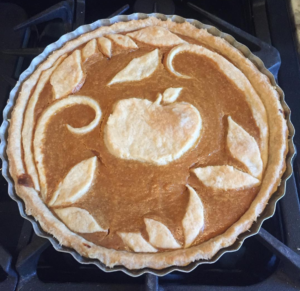 Foods like pumpkin, squash, apples, and nourishing foods help us to balance out the windy, scattered nature of Fall, so our bodies crave this nourishment on a level that we don’t always understand. We are preparing our bodies for the Winter, making sure we have the sustenance to get through.
Foods like pumpkin, squash, apples, and nourishing foods help us to balance out the windy, scattered nature of Fall, so our bodies crave this nourishment on a level that we don’t always understand. We are preparing our bodies for the Winter, making sure we have the sustenance to get through.
I adore Cate Stillman’s work on How to be a Pitta and How to be a Vata. (Though she would probably not be a fan of this classic pumpkin pie that my daughter baked. Moderation, right? Plus, it’s beautiful.)
In addition to foods, you can use your fall yoga practice to balance and settle your energy and come into a space of greater ease.
My student vocalized all of this as we chatted before practice. The desire to cool down from the activity and heat and fire of Summer, AND how she was feeling distracted and scattered. So we used that to guide her 1×1 practice that day. Lots of grounding work to get into the legs and out of the head, and some cooling postures to calm excess heat.
Here is the practice that we did to cool excess fire and settle the energy:
Fall Yoga Practice to Settle and Ground
1. Centering
Focus on grounding down with awareness in the breath moving down, out of head and down into body. You might try the guided meditation on Settling here.
2. Legs Up the Wall
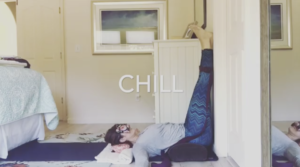 Legs up the Wall, or Viprita Karani, is a cooling posture, and is helpful to reduct excess heat in the body. Watch this video for the setup, or be guided through the whole thing, step by step in this Legs Up the Wall Tutorial. As you rest here, let your leg bones sink into hip sockets.
Legs up the Wall, or Viprita Karani, is a cooling posture, and is helpful to reduct excess heat in the body. Watch this video for the setup, or be guided through the whole thing, step by step in this Legs Up the Wall Tutorial. As you rest here, let your leg bones sink into hip sockets.
3. Supta Padagustasana 1
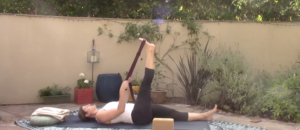 Stay close to the wall after coming out of Legs Up the Wall, and scoot back so that you’re lying on the floor with both feet against the wall, legs straight. Keep one foot on the wall, and bring the other knee to your chest. Ground the bottom thigh and think about plugging the thigh bones of each leg into the hip socket. Go through these stages with the top leg, all the while doing your BEST to keep the bottom thigh connected to the earth all along the back line of the leg. (Just so you know, this is hard for most of us.)
Stay close to the wall after coming out of Legs Up the Wall, and scoot back so that you’re lying on the floor with both feet against the wall, legs straight. Keep one foot on the wall, and bring the other knee to your chest. Ground the bottom thigh and think about plugging the thigh bones of each leg into the hip socket. Go through these stages with the top leg, all the while doing your BEST to keep the bottom thigh connected to the earth all along the back line of the leg. (Just so you know, this is hard for most of us.)
- Top knee bent – while here, tilt your pelvis back and forth…when you tuck your pelvis so that your low back is flat or rounded, the back of your bottom thigh will most likely lift off the ground. What happens when you tilt your pelvis the other direction (and maybe back off the knee coming so close into your chest) so that your low back arches a little bit? Can you get your bottom thigh a little closer to the ground?
- Top leg straight, with hands behind thigh – play with the pelvic tilt again and instead of going for the hamstring stretch, back off that so you can instead prioritize keeping the bottom thigh grounded.
- Top leg straight, with a strap around top foot, straight leg, and then stretch your arms over your head while holding onto the strap (you’ll have to drag your hands down the strap a lot, and you might run out of room…do what you can) – again, try to ground your bottom thigh down, even as distractions in your upper body are greater as you take your arms overhead.
4. Downward Facing Dog –> Vinyasa
 Feel how nice it is to get to something that is familiar and comfortable. Nourishing.
Feel how nice it is to get to something that is familiar and comfortable. Nourishing.
Then move through a Vinyasa, encouraging the shoulders to stay lifted as you lower to the floor, and then feel the pelvis and feet grounding to the floor as you lift up in Cobra or Updog. (Don’t know what a Vinyasa is? Practice some Vinyasa Variations in this short video and pick your favorite way to move.)
5. Surya Namaskar A with Shoulder-Opening High Lunge
Flow through a Sun Salutation (Surya Namaskar A) and step the left foot back to a High Lunge with the back knee lifted (use the linked video for help with this, if you need it):
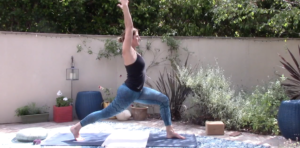
- Hold this Lunge for 3 breaths, feeling the Earth beneath your feet to ground down. Imagine your feet plugging into energy of the Earth through your feet and pulling that energy up your leg bones into the pelvis.
- Take your arms out into a cactus shape (elbow bent out to the side, fingers pointing up to the sky. Then on your exhale, bring the forearms together in front of you. Repeat this 3x with your breath, then reach up. Focus on staying grounded in your legs and your feet, even as you have this distraction of movement in your upper body.
- {Move through a Vinyasa, and optionally add a press up to Plank from the belly on way back to Downdog to plug your hands into the ground and use that energy from the Earth to rise up.}
- Step forward to a Standing Forward Fold (Uttanasana) and then step back with the right foot to repeat this flow on the second leg.
6. “Descend the Femur” Work in Downdog
This is a little drill that I learned from Briophy Smith in her classes on handstand, and it’s called “Descending the Femur.” The femur bone is your thigh bone, and we’ve been working to move the thigh bone more fully into the hip sockets to “plug in” during this practice. So we can think of this as descending the femur bone DOWN. This is the orientation that we worked with in Supta Padagusthasana 1, above. Now, we’re going to do the same work, but upside down in Downward Facing Dog.
- Start in Downdog and make your feet active by trying to lift and spread your TOES (not your heels, your toes!!). Flare your 4th and 5th toes out.
- Transfer the weight into your right foot, and then just flex your left foot so it just hovers above the ground.
- Now pull your whole left leg up into the hip socket. Repeat that 3x on the left side.
- Then switch feet.
This “descend the femur” work helps to energy up from your feet into center, and is great work for feeling stable and connected through the entire body. Remember how this feels…We’ll use this drill work again soon!
7. Warrior 2
From Downdog, step forward and come up into Warrior 2.
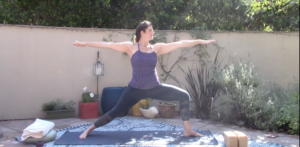
Place your feet so that you feel strong and supported, and imagine pulling the feet toward one another to draw energy in to the center. Then suck the front thigh bone back into the hip socket. Hold here for 5 breaths, grounding down into feet and feeling the breath in your body on breath.
{move through a Vinyasa between sides, putting awareness in the tops of the feet on the ground and the shoulder blades squeezing together on the back in Cobra).
8. Open the Shoulders in Gomukasana
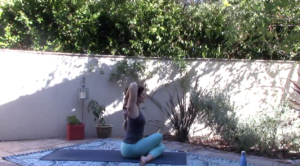 Take any shoulder opener you feel called to. Gomukasana is one option, but if you’re more in the mood for something like Thread the Needle, move through that. You could use this short shoulder sequence to feel where you shoulders are at today. This shoulder work is a preparation for L-Pose / Handstand Prep, so be fluid and listen to what your body is asking for in this direction.
Take any shoulder opener you feel called to. Gomukasana is one option, but if you’re more in the mood for something like Thread the Needle, move through that. You could use this short shoulder sequence to feel where you shoulders are at today. This shoulder work is a preparation for L-Pose / Handstand Prep, so be fluid and listen to what your body is asking for in this direction.
9. L-Pose prep
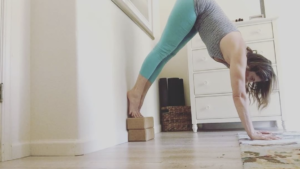
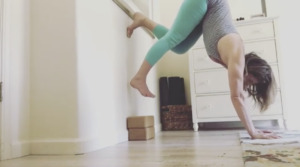 Either revisit the Descend the Femur work in Downward Facing Dog, or grab two blocks and head to the wall.
Either revisit the Descend the Femur work in Downward Facing Dog, or grab two blocks and head to the wall.
This is a prep for L-Pose or Handstand prep that I’ve been teaching for awhile, and it’s a great way to practice moving more weight into the arms as you stack 1-2 (maybe 3???) blocks under the feet against a wall. Hold for 30 seconds. Easy? Add a block. Trembling and losing control? Take away a block. Try to keep arms vertical and PRESS DOWN through your arms. Then…if you’re up for a challenge, take one foot to the wall and try to hover the other foot, foot flexed, and hold for a count of 3. BREATHE. Wherever you are, focus on pulling the leg bones up into the hip sockets to integrate the pelvis for stability. Switch sides. Then climb off the blocks and rest in Child’s Pose.
10. Bridge (3x)
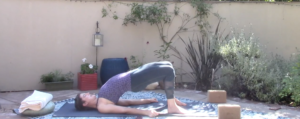
Come down on your back, bend you knees and set the up the feet for Bridge Pose (hip-width distance or a little wider). Really feel the ground underneath your feet and imagine your feet are planting themselves down into the Earth, getting rooted. Take a breath all the way up to the bridge of your nose, and with your exhale, press into your feet and lift the hips up. You may roll the shoulders underneath you and interlace hands behind your back if that is available.
{Lower the hips and relax.}
2nd round of Bridge: Take your feet about 6-12″ further from your hips and repeat Bridge Pose, continuing to focus on feeling your feet pressing down into the Earth. With your feet further from your hips, you may start to feel the backs of your legs (hamstrings) start to engage and work. Enjoy that feeling of work and effort!
{Lower the hips and relax.}
3rd Bridge Pose: If you didn’t feel your hamstrings working on the second round, take your feet even further from your hips, and lift up again. Plug the feet down into the Earth, and feel the circuitry of your body using the energy from the ground. Alternatively, you could walk your feet in closer, and REMEMBER the feeling of the feet plugging into the Earth. Use that to lift the hips higher.
Now relax. Take any final movements, like a Spinal Twist or Happy Baby to close our your practice before Savasana.
11. Savasana with weight on thighs
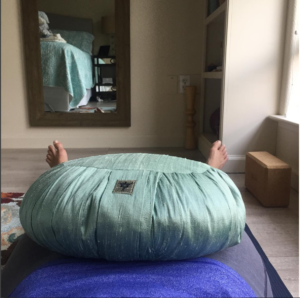
This is one of my favorite ways to chill, relax, and ground down in Savasana. Grab something heavy-ish, like a bolster, pillow, or blanket, and just lay it across the tops of your thighs. Let the weight of this prop further allow your body and attention to move DOWNWARD into the Earth. Rest here for at least 5-6 minutes.
Awaken. Continue to feel the shift of energy moving down, out of the air and toward the Earth. See if you can remember through the day to feel your feet on the ground, and the breath in your belly, even when (or ESPECIALLY when) things around you feel distracted and chaotic.
May we be settled and calm.
Namaste.

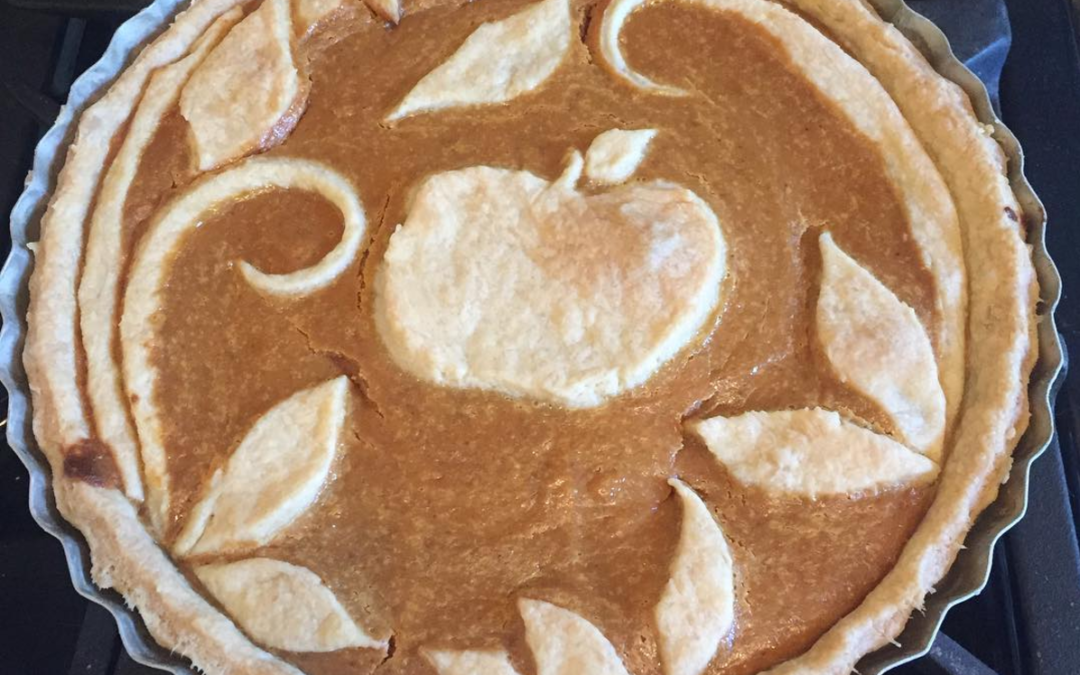
 Empowering women who are 40+ to install movement habits that are nourishing, strengthening, and approachable for a truly calm and connected life.
Empowering women who are 40+ to install movement habits that are nourishing, strengthening, and approachable for a truly calm and connected life.